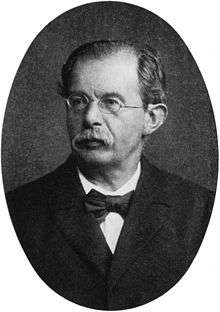Friedrich Daniel von Recklinghausen
| Professor Friedrich Daniel von Recklinghausen | |
|---|---|
 | |
| Born |
2 December 1833 Gütersloh |
| Died |
26 August 1910 (aged 76) Strasbourg |
| Nationality | German |
| Known for | Iron overload |
| Scientific career | |
| Fields | Pathology |
| Institutions | University of Strasbourg |
| Doctoral advisor | Rudolf Virchow |
| Notable students | |
Friedrich Daniel von Recklinghausen (German: [ˈʁɛklɪŋhaʊzən]; 2 December 1833 – 26 August 1910) was a German pathologist born in Gütersloh, Westphalia. He was the father of physiologist Heinrich von Recklinghausen (1867–1942).
Academic background
He studied medicine at the Universities of Bonn, Würzburg and Berlin, earning his doctorate at the latter institution in 1855. Afterwards he studied pathological anatomy under Rudolf Virchow, the father of modern pathology, and obtained his doctorate with Virchow as his advisor. He subsequently undertook an educational journey to Vienna, Rome, and Paris. From 1866 to 1872 he was a professor at the University of Würzburg, and for more than three decades (1872–1906), a professor at the University of Strassburg. At Strassburg he helped to recruit a number of important people to the school, such as anatomist Wilhelm von Waldeyer-Hartz (1836-1921).
Contributions
In 1882 Recklinghausen released a monograph that reviewed previous literature and characterized the tumors of neurofibromatosis type I or NF-1 as neurofibromas, consisting of an intense commingling of nerve cells and fibrous tissue. NF-1 is sometimes referred to as "von Recklinghausen syndrome".
In 1889 he coined the term "haemochromatosis", and was the first to provide the link between haemochromatosis and iron accumulation in body tissue. Recklinghausen published his findings in a treatise titled Hämochromatose (1889).
He is credited with establishing a method for staining lines of cell junctions with silver, a procedure that led to Julius Friedrich Cohnheim’s research on leukocyte migration and inflammation. In 1910, he coined the term oncosis (derived from ónkos, meaning swelling). This term is sometimes used to describe Ischemic cell death.[1] In addition, he is credited with performing important studies on the heart and circulation.
Written works
- Die Lymphgefässe und ihre Beziehung zum Bindegewebe (1862).
- Ueber Eiter- und Bindegewebskörperchen in Virchow's Archiv für pathologische Anatomie und Physiologie, und für klinische Medicin, Berlin, (1863), 28: 157-197. Here Recklinghausen described granular cells in the frog mesentery, later named "mast cells" by Paul Ehrlich (1854-1915).
- Über die multiplen Fibrome der Haut und ihre Beziehung zu den multiplen Neuromen. Festschrift für Rudolf Virchow. Berlin, (1882). (treatise on Recklinghausen’s disease).
- Handbuch der allgemeinen Pathologie des Kresilaufes und der Ernährung. In Theodor Billroth and Georg Albert Lücke, publishers: Deutsche Chirurgie, Lfg. 2, 3, Stuttgart, (1883).
- Hämochromatose. Tageblatt der Naturforschenden Versammlung (1889), Heidelberg, 1890: 324.
- Ueber Akromegalie. Virchow's Archiv für pathologische Anatomie und Physiologie und für klinische Medizin, Berlin, (1890), 119: 36.
- Demonstration von Knochen mit Tumor bildender Ostitis deformans. Tageblatt der Naturforschenden Versamlung 1889. Heidelberg, (1890), p 321.
- Osteoplastische Carcinose in ihren gegenseitigen Beziehungen. Festschrift für Rudolf Virchow. Berlin, Georg Reimer Verlag, 1891[2]
See also
References
- ↑ Majno, G; Joris (1995). "Apoptosis, oncosis, and necrosis. An overview of cell death". Am. J. Pathol. 146 (1): 1–2, 16–19. PMC 1870771. PMID 7856735.
- ↑ Friedrich Daniel von Recklinghausen; bibliography at Who Named It
- Ole Daniel, Enersen. "Friedrich Daniel von Recklinghausen". Who Named It?. Retrieved 2007-01-23.
- Bonah, Christian (2003). ""Realpolitik": Friedrich von Recklinghausen's pathology for the kaiserreich". Neuere Medizin- und Wissenschaftsgeschichte. Germany. 6: 77–104. PMID 15043061.